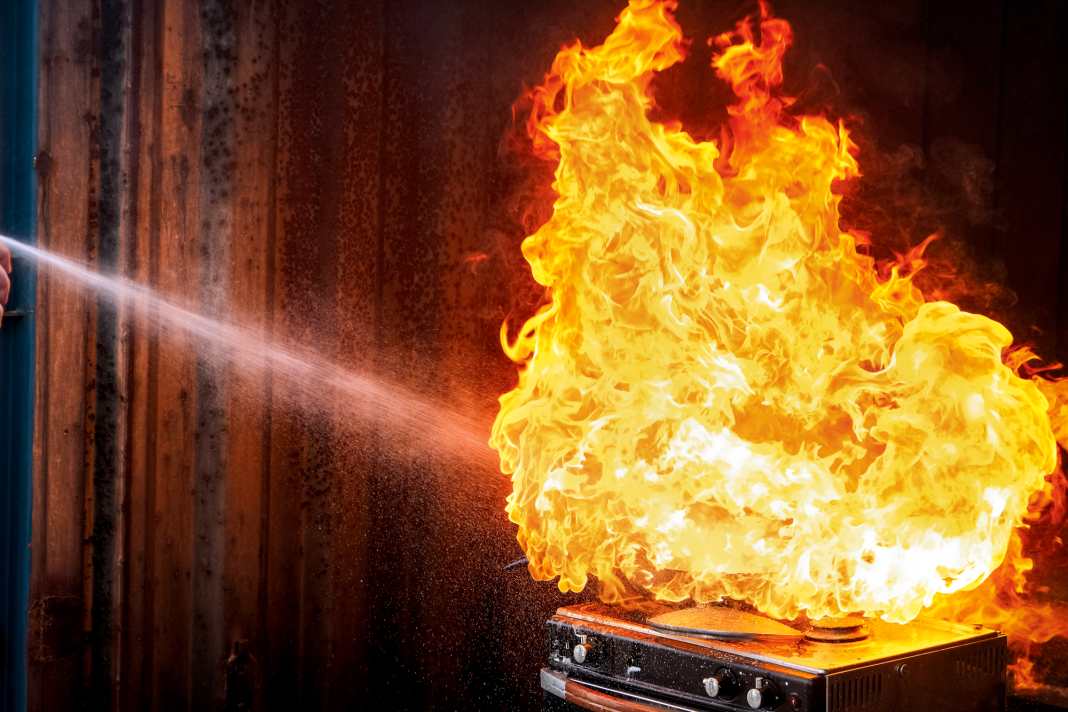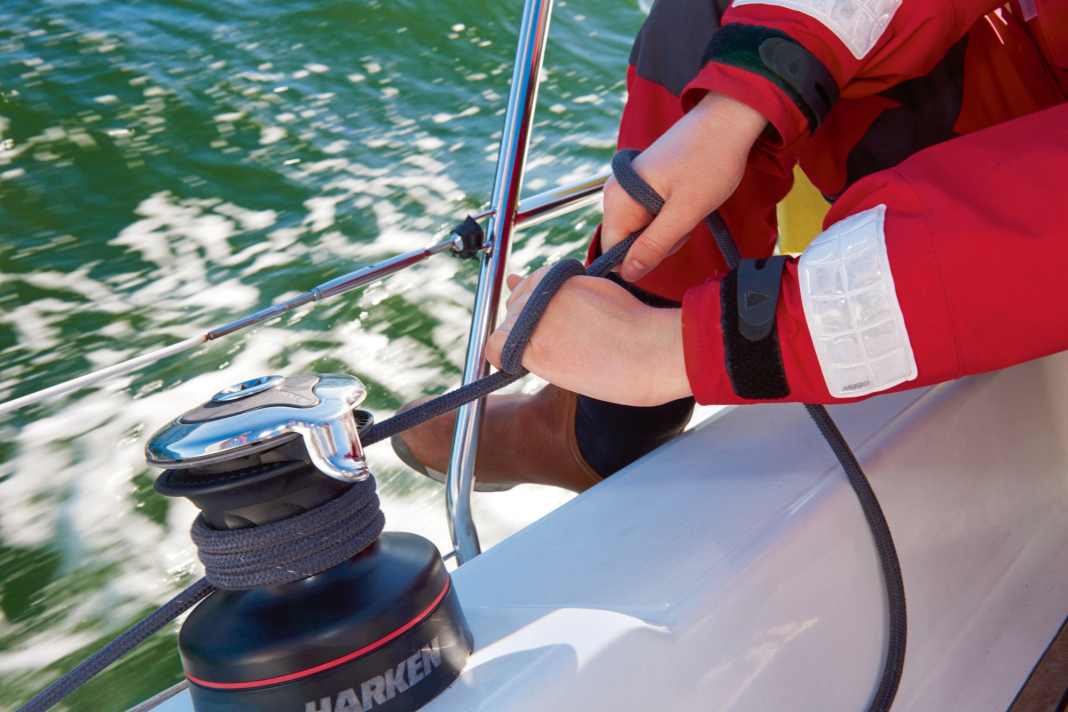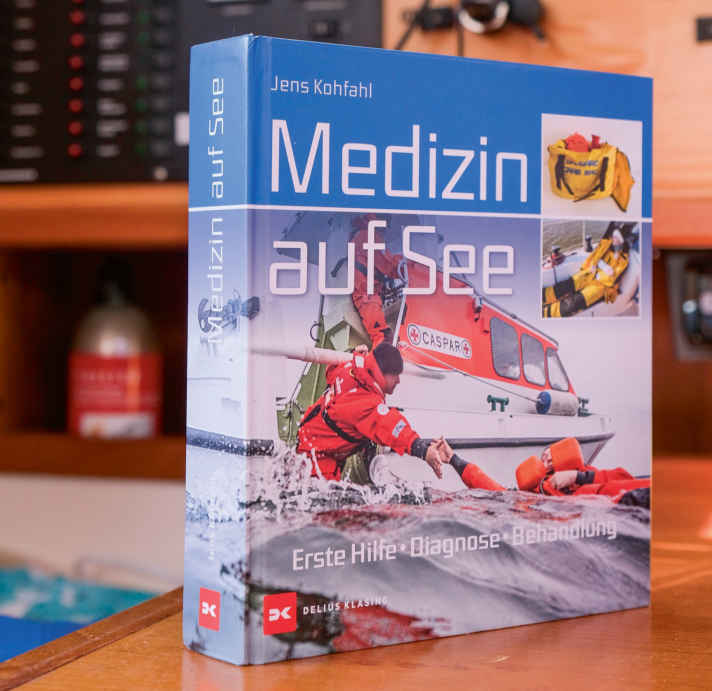





Which MOB manoeuvre is most promising, which Rescue equipment is the safest way to get the crew member back on deck? And if all that doesn't work, with which Emergency transmitter on the lifejacket can you find the person in the water? Or which Fire extinguisher is the most reliable way to smother the flames? YACHT frequently tests equipment that can help after accidents or in acutely dangerous situations. The aim is to solve problems. It would be even better if these problems did not arise on board in the first place. To avoid accidents, it is important to know the causes. So: What can happen?
By the way: If something has already happened, you will find tips on how to treat the most common injuries in this guide. Injuries on board.
The areas on deck and below deck can be roughly categorised. This is where situations can arise in which people could be injured or the yacht could be lost. On deck, the danger of tripping and falling is the most important. This is often caused by fittings such as railing supports or rails. Without shoes, this can lead to injuries to the feet. There is also always the risk of falling overboard. In addition, hands can be injured on winches, lever clamps or mooring lines. In the rig, the greatest danger comes from the main boom. The traveller and mainsheet must also be taken into account when manoeuvring.
Main sources of danger on board
- Sun Concentrating at the wheel for hours on end, it's easy to forget to wear sunscreen and drink.
- Large tree Boom hits head, the classic. Painful on a dinghy, potentially fatal on a yacht.
- Winches Sheets under load have enormous force. Operate the lines at a safe distance.
- Drive The propeller is a danger to people in the water, especially on small boats or cats.
- Machine In the event of a malfunction, the diesel can discharge exhaust gases into the ship and cause fires.
- Mainsheet The buoy can lash out during manoeuvres. The traveller also poses a risk of injury.
- Latch stopper Just open a clamp? Not a good idea! Always put it around the winch when loaded!
- Danger of falling Exists on and below deck in rough seas. Particularly dangerous when cooking.
- MOB Leaving the cockpit and going forward harbours the risk of falling overboard.
- Mooring lines The lines can suddenly tighten. Get your feet out of the way and put your gloves on!
- Mooring line Often overgrown, the sharp-edged shells can cause cuts.
- Cooking The number one fire hazard and, at sea, the risk of scalding yourself or others.
- Electrics Incorrect installation can result in navigation failure and, in the worst case, fire.
- Gas Is the outlet of the gas box clear? Has the system been serviced regularly?
There is also a risk of falling when climbing into the mast. This article explains how to get into the mast safely in 14 tips for staying explained. Protruding cardeels on defective wire traps are also a major risk of injury to the hands.
There are three main areas below deck: Galley, plumbing and the general risk of falling. Sometimes it's a mixture, so losing your balance while cooking with a pot of boiling water can lead to serious scalds. Installations for gas, electrics and machinery harbour danger in the event of malfunctions, which can quickly result in the loss of the yacht. Related to this is the potential danger from gas: carbon monoxide, which is extremely toxic, and propane, which is highly flammable.
Twelve rules of behaviour that can help prevent most accidents on board:
- One hand for yourself, one hand for the ship.
- Always pay attention to the boom in the cockpit.
- Increased vigilance also below deck in bad weather.
- Protect your feet with suitable footwear.
- Wear a lifejacket and peck in during bad weather or at night.
- Wear oilskin trousers and safety harness when cooking at sea.
- Don't forget to eat, drink and use sun protection.
- Rest and sleep whenever possible.
- Good communication with the crew during manoeuvres, but also when planning the trip.
- Do not drink alcohol at sea.
- Keep physically fit.
- Strictly adhere to all maintenance and inspection intervals.
Many of these recommendations are automatically followed by sailors. Nevertheless, it can help to realise what the consequences of ignoring the first rule alone can be. Many dangers can be eliminated through good preparation. For example, the risk of fire increases if maintenance is neglected; if everything is up to date, the risk is also reduced enormously. Once all safety-related preparations have been made, you can enjoy your time on the water without imagining horror scenarios.
Man Over Board
Manoeuvres and rescue equipment should be tried and tested. However, it is better to prevent the fall altogether.
Prudence and a hand on the boat do not always help. Especially in heavy weather or at night, crew members should also secure themselves with a line. Safety lines must be ready to hand and life jackets with harnesses must be worn. In addition, the mooring ropes on deck must be positioned sensibly. If they are too loose and too close to the side of the boat, they may not prevent a fall at all. After all, although there is then a line connection, the person is still hanging in the cold water and getting back on deck can be a challenge.
It's better to check the positioning of the spreader ropes in the harbour and improve them if necessary. It may also be advisable to go to windward on the forecastle, as you will fall onto the deck if you lose your balance and not outboard. Lines that have been jerked once must be replaced. More about the right Dealing with lifelines you can find out here.





Lifejacket
If a crew member is in the water, something has already gone very wrong in terms of hazard avoidance. Nevertheless, sailors should also be prepared for this. A good lifejacket increases the chances of being found alive enormously. All models in the buoyancy class with 275 Newton and more should also turn unconscious persons onto their backs. An emergency light or transmitter then makes it easier to find them again. A spray cap is essential in rough seas so that you can breathe freely without choking on spray and drowning. Here you can find our large Lifejacket comparison test.
Safety line
Conventional carabiners on safety lines can get caught in padeyes or under cleats in such a way that they open or bend open under load. It is better to use hooks with an additional safety device, and stretch ropes should be routed in such a way as to avoid such danger points as far as possible.
Propeller
On catamarans, the drives are usually very far aft and can be reached with the feet. In MOB situations, special care is therefore required when manoeuvring alongside people. Particularly when crew members are being lowered out of the water via the swim ladder: disengage the engine.
Fire on board
A fire is probably the biggest disaster on a boat. Attempts to extinguish a fire are very dangerous.
A fire that gets out of control forces the crew to leave the boat immediately. Attempts to extinguish the fire are dangerous due to the usually limited ceiling height, as the flames spread backwards instead of upwards. If there is a fire on the cooker, the gas should be switched off first. If the shut-off valve can be reached near the hob, all the better. Otherwise, switch it off in the gas box on the cylinder. Our extinguishing tests on grease fires have shown that simply switching off the hob and placing a lid over the flames can extinguish an incipient fire. Never pour water into burning fat, there is a high risk of explosion!
The second common cause of fire is faulty electrical installation. However, regular checks are advisable even if the wiring is well installed. This is because corrosion or screw connections loosened by vibration can lead to high contact resistances and thus heat development. Fire extinguishers must be available in several places in case of an emergency.
Read on to find out how to react in an emergency and what preventive measures you should take. in this article.






Fuel
Propane and butane are heavier than the ambient air and therefore collect in the bilge. To reduce the risk of fire, check the ventilation of the gas locker. A gas alarm is a sensible investment.
Combustion, gas, fire
There is a threefold danger in the galley: secure the pans well in rough seas, oil trousers help prevent scalding. Unattended pans are a grease fire hazard. Carbon monoxide can also be produced: Never use the cooker for heating!
Machine
A loose hose clamp on the manifold is enough to allow cooling water and exhaust gases to enter the ship. Diesel leaks can also pose a fire risk. For example, if the fuel leaks into the engine compartment insulation and is then ignited by a short circuit. It helps to keep the engine compartment clean so that leaks can be quickly recognised and eliminated. The edges of the insulation material should also be sealed with tape.
Electrics
If the power supply fails, navigation or lighting will also be missing. Loose cable and crimped connections can also cause a lot of heat and even a fire. The cable cross-sections must also be suitable for large consumers.
Cordage
Sheets and traps are particularly risky for the hands. A few rules protect against injuries.
The potential danger posed by ropes is often underestimated. The problem: under load, the actually supple material can turn into a real skin cutter if it slips through unprotected hands. Calluses and blisters tend to be harmless, while severe abrasions and burns are more serious consequences.
Sailing gloves reduce the risk of injury, but even more important is the correct handling of the cordage. This starts with the grip. A common mistake is to wrap the line around the hand for more grip. However, this prevents it from being fully released and eats into the flesh. Better: hold it in your fist like a microphone. If you open your fist, the line falls out of your hand and runs out without causing injury.
In addition, there should always be sufficient safety distance from winches, clamps and cleats so that the hand is not pulled into the fitting before it can release the line.






Winches
If you hold the line too close to the drum, you run the risk of being pulled in by hand. In addition, the sheet should never be looped around your hand. This is because it cannot simply be released in an emergency. If the line starts to slip, it will cut painfully into your flesh. It is better to grasp it with your fist, as shown below.
Schot-Taljen
Tackle reductions convert power into travel, which helps when hauling tight. Conversely, the sheet pull generates enormous rope speeds when fising, so the line should only be fished hand over hand or let go completely. A rope slipping through the hand generates so much frictional heat that it quickly causes burns, and the line also grinds through the skin at lightning speed. Sailing gloves and a fist grip significantly reduce the risk of injury.
Latch stopper
How much load is on a line fixed in the stopper is often underestimated. If you open the cleat, not only does the rope suffer, it can also be pulled through your hand, which can lead to burns and abrasions, just like on sheets and winches. The halyard should therefore be placed on the winch and cranked up. It is then furled over the winch in a controlled manner with the cleat open.
Wire traps
Metal halyards are rarely found on board - which is a good thing, as they tend to form meat hooks. The area directly behind the shackle is particularly at risk, as it lies on the halyard disc when the sail is set and is rolled through with every change in load, causing the material to fatigue and individual carding elements to break. These thin wires then protrude as tips. Wear gloves or convert to Dyneema halyards.
Mooring lines
The mooring lines lie on the bottom most of the time and are correspondingly dirty and often overgrown with sharp-edged mussels and pockmarks. As they have to be moved quickly to the bow when mooring, there is a risk of cutting. It is best to pick the mooring with a hook and wear gloves when mooring.
Mooring lines
Long shore lines quickly become a shackle if you step into a loop lying on deck while handling them. In addition, the ropes should be routed around a cleat so that you don't have to absorb sudden loads with your hands and back.
Book: Medicine at sea

If prophylaxis does not help and something does happen, in "Medicine at sea" by Jens Kofahl to read how the crew treats various injuries at sea without a doctor. Delius-Klasing, 59.90 euros.

